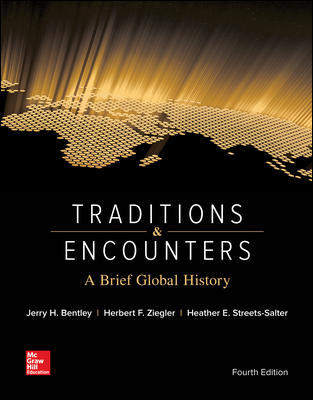Description
Traditions & Encounters A Brief Global History 4Th Edition By Jerry Bentley – Test Bank
Chapter 03 Early Societies in South and East Asia
Multiple Choice Questions
1. (p. 45) The chief god of the early Aryans was
A. Enlil.
B. a mother goddess.
C. Varuna.
D. Indra.
E. Manu.
Accessibility: Keyboard Navigation
Topic: Harappan Society
2. (p. 46) The earliest known civilization in India was the
A. Bantu.
B. Indo-European.
C. Harappan.
D. Sumerian.
E. Hindu.
Accessibility: Keyboard Navigation
Topic: Harappan Society
3. (p. 46) Much of early Harappan history remains a mystery because
A. the archaeological remains are below the existing water table.
B. the Harappans lacked a written language.
C. Harappan records were destroyed in a Mesopotamian invasion.
D. the Aryans undertook a systematic destruction of Harappan written records.
E. the archaeological remains are below the existing water table, and the Harappans lacked a written language.
Accessibility: Keyboard Navigation
Topic: Harappan Society
4. (p. 46) If the Greek historian Herodotus had known of the Harappan society, he might have used the phrase “the gift of the ________” to describe it.
A. Nile
B. Tigris
C. Indus
D. Yangze
E. Euphrates
Accessibility: Keyboard Navigation
Topic: Harappan Society
5. (p. 47) Mohenjo-daro was
A. the mother goddess of the earliest Indian society.
B. an important early thinker in the rise of Hinduism.
C. one of the two main cities of the Harappan society.
D. a collection of early Indian religious texts.
E. the combination of two Indian sun gods.
Accessibility: Keyboard Navigation
Topic: Harappan Society
6. (p. 47) Two especially prominent cities of the first Indian society were Harappa and
A. Mohenjo-daro.
B. Babylon.
C. Calcutta.
D. Uruk.
E. Tyre.
Accessibility: Keyboard Navigation
Topic: Harappan Society
7. (p. 47) Based on archaeological evidence from early Indian history, historians believe that
A. Harappa and Mohenjo-daro served as economic and political centers.
B. the Harappan world was one of constant civil war.
C. the Chinese were a constant influence.
D. there was little true culture in India before the arrival of the Indo-Europeans.
E. early Indian cities remained small and unsophisticated by comparison to other ancient cities.
Accessibility: Keyboard Navigation
Topic: Harappan Society
8. (p. 47) At its height, the population of Mohenjo-daro reached
A. 10,000.
B. 20,000.
C. 40,000.
D. 75,000.
E. 100,000.
Accessibility: Keyboard Navigation
Topic: Harappan Society
9. (p. 47) Evidence relating to trade indicates that Harappan India
A. was isolated and did not trade.
B. traded exclusively with China.
C. traded exclusively with Persia.
D. imported substantially more than they exported.
E. traded with Mesopotamia and Persia.
Accessibility: Keyboard Navigation
Topic: Harappan Society
10. (p. 46-48) Which of the following statements about Harappan society is FALSE?
A. Most of their houses featured private rooms for bathing and toilets.
B. They traded extensively with the Mesopotamians.
C. They had social distinctions.
D. Their writings have provided a wealth of information for historians.
E. Major cities were laid out on a planned grid.
Accessibility: Keyboard Navigation
Topic: Harappan Society
11. (p. 48) Harappan religion
A. focused on the worship of the sun.
B. was strongly monotheistic.
C. reflected a strong concern for fertility.
D. focused on the worship of the moon.
E. is the same as Hinduism.
Accessibility: Keyboard Navigation
Topic: Harappan Society
12. (p. 48) Some scholars believe that, after the collapse of the Harappan society, Harappan deities
A. disappeared completely.
B. quickly became the only gods of the Indo-Europeans.
C. survived and found a place in the Hindu pantheon.
D. survived in southeast Asia after the Harappan migration.
E. were transformed into destructive dragons by the Aryans.
Accessibility: Keyboard Navigation
Topic: Harappan Society
13. (p. 48) One of the biggest reasons for the decline of the Harappan society was
A. a devastating plague.
B. ecological degradation.
C. a Chinese invasion.
D. a Mesopotamian invasion.
E. a bloody civil war.
Accessibility: Keyboard Navigation
Topic: Harappan Society
14. (p. 48) The Aryans were
A. the priestly class of the Harappan society.
B. Chinese merchants.
C. the political remnants of the Harappan kings.
D. Indo-Europeans.
E. Germanic invaders.
Accessibility: Keyboard Navigation
Topic: Indo-European Migrations and Early Vedic India
15. (p. 49) The Aryans came into India
A. in a centuries-long migration.
B. as part of a violent, organized military campaign.
C. as religious pilgrims.
D. after fleeing persecution in China.
E. as a slave class that eventually rebelled against Harappan repression.
Accessibility: Keyboard Navigation
Topic: Indo-European Migrations and Early Vedic India





Be the first to review “Traditions & Encounters A Brief Global History 4Th Edition By Jerry Bentley – Test Bank”